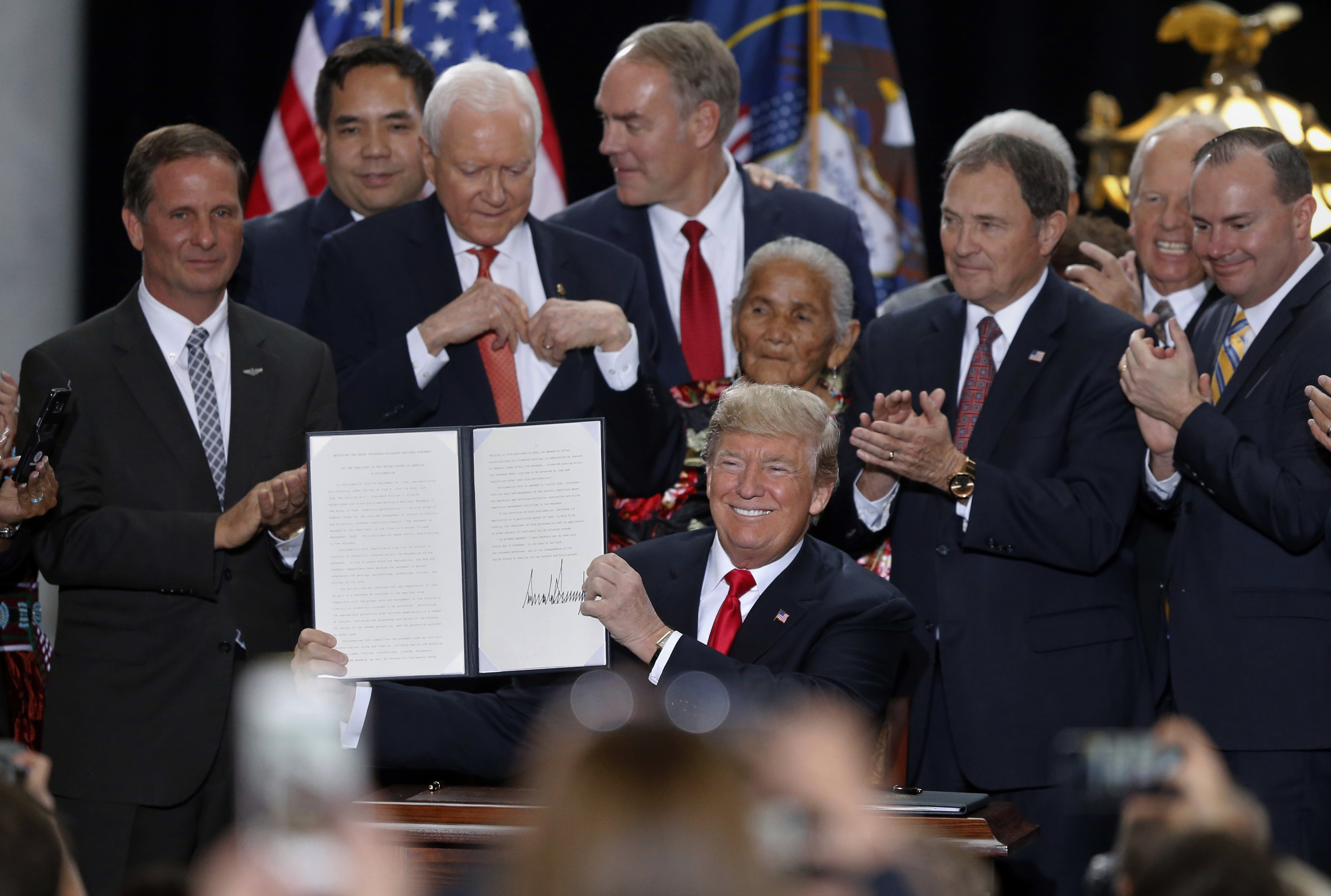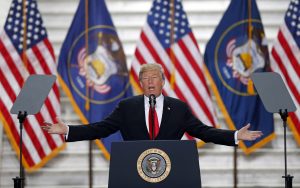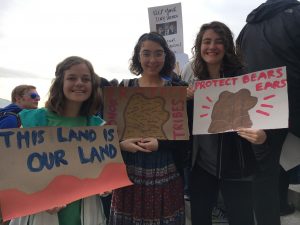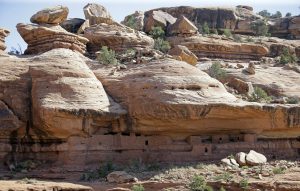
Since President Donald Trump’s Dec. 4 proclamation to reduce the size of two Utah national monuments, Utahns have voiced their opinions about the change.
According to a Bureau of Land Management press release, Utahns will be able to input comments for the new land use plans for the Bears Ears National Monument.
The Bureau of Land Management Utah State Office has started a public scoping period where the public can input comments “in advance of preparing land use plans for Bears Ears National Monument as modified by Proclamation 9681,” according to the press release.
The Bureau of Land Management will be accepting comments for at least 60 days, 15 days after the final public scoping meeting.
This public scoping period comes after Utahns have shared their opinions about shrinking the Bears Ears National Monument.
Some Utah Native Americans have expressed the act is unlawful because historically, presidents have only had the ability to create national monuments — not shrink them.
Jacqueline Keeler, contributing writer and editor of the book “Edge of Morning: Native Voices Speak for the Bears Ears,” said most Navajos (98 percent) support the original Bears Ears National Monument because it protects the land from mining and looting.
However, Utah legislatures take the position that shrinking the monuments will aid Utah’s economy and eliminate the federal government’s overreaching power to take land away from citizens.
History of creating monuments
Congress passed the American Antiquities Act in June 1906. This act gives the president of the United States power to appoint land for national monuments.
Map created by Kelsey Pennock
Presidents Theodore Roosevelt, Bill Clinton and Barack Obama created more national monuments under the Antiquities Act than any of the other presidents, with 18, 19, and 26 national monuments designated respectively.
In December 2016, President Barack Obama issued a statement to designate 1.9 million acres of land in San Juan County, Utah as the Bears Ears National Monument.
Since the proposal of Bears Ears, some Utah legislators have opposed the decision, saying the monument will keep Utahns in the area from doing things such as farming to sustain their way of life, even as it allows Native Americans to protect their ancestral lands.
A June 10 memorandum issued by Secretary of the Interior Ryan Zinke called for Trump to decrease the size of the Bears Ears National Monument.
The Utah state legislature’s response to Zinke’s memorandum was 49 pages long and discussed the reasons for shrinking the monument, according to Keeler.

Despite this, Trump’s decision to shrink the national monument has proven to be controversial among Utahns affected by the decision.
“(The memorandum Zinke issued) basically said the main issue for (Utah legislators) was that (Bears Ears) threatened the uranium industry in Utah,” Keeler said.
The decision to shrink Bears Ears
Trump’s proclamation reduces the land for Bears Ears National Monument from roughly 1.3 million acres (2,031 square miles) to 201,876 acres (315 square miles) and the Grand Staircase Escalante National Monument from nearly 1.9 million acres (nearly 3,000 square miles) to 1,003,863 acres (1,569 square miles).
Utah legislators at the event thanked Trump for giving Utah residents a voice, but such a decision has brought controversy to the state and is expected to bring a legal battle between Utahns, Native Americans and environmentalists who oppose shrinking the monument, and the Utahns and Utah legislators who support it.
Utahns react to Trump’s announcement

BYU sophomore Halli Boman said she went to the Utah Capitol building on Dec. 2 to protest the shrinking of Bears Ears and Grand Staircase Escalante national monuments.
“Everyone who attended (the rally) cared deeply about preserving the monuments for various reasons: recreation, environmentalism, cultural or spiritual beliefs,” Boman said.
According to Boman, Trump’s decision will negatively influence the environment because of mining or oil drilling operations that can destroy the beautiful land in the area.
Boman also said this decision could cause other states to decide that temporarily quick income from mining and drilling is more important than protecting and preserving American land.
University of Utah junior Keven Carlson said he is against Trump’s decision to shrink the national monuments because it is an unnecessary political move that risks protection for land that is special to many people and initially preserved for a reason.
“Bears Ears National Monument was created to respect and honor Native Americans, as it is their ancestral land, and it is a part of their spiritual practices,” Boman said. “Additionally, national monuments are great places for people to learn to appreciate and enjoy nature. When people get to experience the beauty of the earth for themselves, they are more likely to make environmentally responsible decisions.”
Keeler said the media’s portrayal of the topic of Bears Ears isn’t an accurate telling of the public’s opinion.
“The national monument proposal was created by five (indigenous) tribes … who have ties to that area going back thousands of years. There are over 100,000 archeological sites that go back nearly 12,000 years,” Keeler said. “So it represents an incredible connection that far predates the creation of the state of Utah or the county of San Juan.”
The land requires oversight and protection because of its history and value, Keeler said, and this is why the tribes initially proposed it for national monument status.
“The proposal was the work over several years of these nations working together to appeal to protect these areas as quickly as possible because they were under active looting,” Keeler said.
However, Utah legislators have said Trump’s decision is in direct response to concerns about land restrictions.
For example, Senator Mike Lee issued a Dec. 4 release, which said, “President Trump did the people of Utah a great favor today by rolling back harmful land use restrictions in southern Utah.”
Lee went on to say that now Congress needs to address the issue of the Antiquities Act to prevent further federal overreach in creating future national monuments.
The release also stated Lee will introduce a bill that will give Utah protections from the Antiquities Act and give state and local leaders, plus tribal members, the power to oversee the national monuments with the new boundaries issued by Trump. Lee’s bill will also provide Congress and the Utah legislature to approve all future Utah national monuments.
Positive effects of shrinking Bears Ears
There are some economic benefits to shrinking the land, according to Carlson.
“There’s economic growth that can happen if it’s not public land. If it’s privatized, they can have economic growth, they can farm the area, have cattle in the area and do other things,” Carlson said.
There are also economic benefits in uranium mining in the area as well as the political benefit of restricting further federal overreach.
Matthew Anderson is the director of Sutherland Institute’s Coalition for Self-Government in the West. Anderson commented on Trump’s decision to shrink the national monuments and how it addresses the topic of federal overreach in a Dec. 4 press release.
“Without substantive reform to the Antiquities Act, our national monuments will continue to be popular political footballs being punted back and forth with each change in presidential administration. No one wins in such a kicking game — not our public lands, not the antiquities themselves, and certainly not the people who live in the West’s rural communities,” Anderson said. “It’s time for all sides to draw on their shared love of public lands and come to a permanent solution.”
Negative effects of shrinking Bears Ears
Many environmentalists, Native Americans, and other Utahns said shrinking the monument will bring more negative effects than positive to Utah.

“Anything can happen to those lands now,” Carlson said. “The environment and the culture of the Native Americans could be lost. There are lots of artifacts and cool areas that have Native American history there that could be lost with the development of the area.”
Boman said her opposition to shrinking the monument stems from the need to respect Native American lands and to do everything to protect them.
The five Native American nations who proposed the formation of the Bears Ears National Monument represent national histories and should be decided on in a nation-to-nation manner instead of “choosing individual citizens of those nations to represent them,” Keeler said.
Establishing the land as a national monument protects the land from looting, vandalism and mining, which are currently taking place in the area of Bears Ears, according to Keeler.
The outdoor recreation Utah offers has also been affected by this decision to shrink Bears Ears. According to Carlson, the outdoor retail expo show — something that brought millions of dollars to Utah’s economy — moved to Colorado due to Trump’s decision to shrink the monument.
A coalition was created to protect Bears Ears. Members of the coalition include Patagonia Works, Utah Diné Bikéyah, Friends of Cedar Mesa, Archaeology Southwest, Conservation Lands Foundation, Access Fund, the Society for Vertebrate Paleontology, and the National Trust for Historic Preservation.
Together, the coalition sued the Trump administration for the president’s decision to shrink the Utah national monuments.
A press release was issued on Dec. 6 giving the reasons for the lawsuit.
“The President’s proclamation is contrary to law, ignores overwhelming public support for the original monument designation, and dishonors Native American heritage and culture,” the coalition members said.
Josh Ewing is the executive director of Friends of Cedar Mesa.
“With more than 100,000 archaeological sites, 75 percent of which were erased from the National Monument by President Trump, the Bears Ears landscape is unquestionably the kind of place the Antiquities Act was meant to protect,” Ewing said in the press release.
Keeler also said the Antiquities Act only allows Congress to shrink national monuments, while presidents have the legal right to create them. This fact has sparked the legal battle regarding Trump’s decision.
“This extreme and unprecedented effort by the President to erase National Monument protections … leaves us no choice but to pursue our legal rights in the American system of justice,” Ewing said.
Uranium industry effects
One of the positive effects of shrinking Bears Ears that Utah legislators see is protecting the uranium industry in the area.

Over 500 abandoned uranium mines are in the Navajo Nation and not much is being done regarding clean up, according to Keeler.
“Navajo people have uranium levels in their bones. That is higher than 95 percent of the population. Navajo babies have uranium in their urine. They estimate it will take 100 years to clean up these mines and $4 billion to $6 billion. Only one of (over 500) mines has been cleaned up,” Keeler said.
Keeler’s family lives near a uranium mine near the south rim of the Grand Canyon and is affected by the lack of uranium cleanup. Back in October, there were Geiger counter readings done by her grandparents’ house to test the uranium in the area.
“They were at Fukushima levels. So, it’s very dangerous,” Keeler said. “In fact, the folks who were doing the readings felt like they couldn’t stay, and my family lives there.”
Native Americans already have a hard time finding jobs, effectively making them refugees on their own reservations, Keeler said. And now, Native Americans have become environmental refugees because of the reduced federal protection over their lands.
“Poisoning these communities has real outcomes,” Keeler said. “Zinke talks about passing on energy dominance to our children and grandchildren … But what is he passing on to our children and grandchildren? It’s not clean up, which we need. It’s something else,” Keeler said.
What’s next for Bears Ears?
At a conference in Phoenix in the beginning of December, Keeler met with lawyers from the Native American Rights Fund who are representing some of the plaintiffs in the lawsuit.
Keeler said the legal scholars are fairly confident the law is on their side since nothing in the law gives presidents the legal right to reduce monuments.
However, Keeler said she isn’t confident the law will be read fairly, due to the political leanings of members on the Supreme Court and because of the severability clause Trump included in the proclamation.
The severability clause states that even if the courts say Trump doesn’t have the right to shrink monuments, Trump’s decision will still remain.
Kimball Bighorse is a citizen of the Cayuga Nation whose father is of the Navajo tribe. Bighorse contributed a chapter about Bears Ears to the book Keeler edited.
Bighorse said the Bears Ears Inter-tribal Coalition, which consists of representatives from five tribal nations united to protect the Bears Ears area, is hoping to achieve two things: to work nation-to-nation with tribes on “an issue that affects lands that are outside current reservation boundaries” and to help protect the land from “encroachers and exploiters.”
The future of the Bears Ears National Monument remains uncertain; however, Utahns continue to express their opinions. Carlson said Utah’s culture respects public lands and the beauty of the area.
“I think that’s part of Utah’s culture and that’s what it should be,” Carlson said. “We should embrace that instead of fighting against it for other nonrenewable economic advances.”
The dates and times of the public scoping meetings can be found at the Bureau of Land Management website.
For more information about the Bears Ears Monument conversation in Utah, visit universe.byu.edu.




